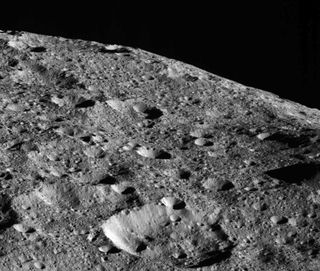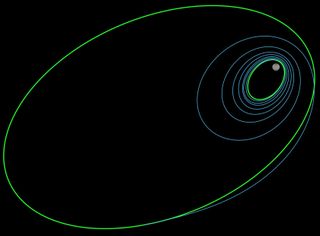NASA Is About to Have Its Closest Encounter Ever with Dwarf Planet Ceres

A NASA spacecraft is about to get up close and personal with Ceres, a giant asteroid that also happens to be the only dwarf planet in the inner solar system.
This month, NASA's Dawn spacecraft will shift into an orbit that will skim just 22 miles (35 kilometers) above Ceres at its closest point, allowing Dawn to get its best views yet of the dwarf planet. At its farthest point, the new elliptical orbit will carry Dawn out 2,500 miles (4,000 kilometers).
"The team is eagerly awaiting the detailed composition and high-resolution imaging from the new, up-close examination," Carol Raymond, principal investigator for the Dawn mission at NASA's Jet Propulsion Laboratory, said in a statement. "These new high-resolution data allow us to test theories formulated from the previous data sets and discover new features of this fascinating dwarf planet." [See Dawn's Amazing Photos of Dwarf Planet Ceres]
One target on Ceres is especially tantalizing during the new, lower orbit. That's Occator Crater, a place with strange, bright white spots.
"As a bonus objective, scientists would like to study the elements in one of their favorite places (and perhaps one of yours as well): Occator Crater, site of the highly reflective salt deposits, famous not only on Ceres but also on Earth and everywhere else that readers follow Dawn's discoveries," Marc Rayman, mission director and chief engineer for Dawn at JPL, wrote in an April 29 blog post. "Studying this one crater and the area around it (together known as a geological unit) could reveal more about the complex geology there."
At its lowest point, Dawn will be 10 times closer to Ceres than the probe has ever been. In fact, Rayman said it will be the closest Dawn has been to an object in the solar system since it launched from Earth.
"The last time it was that close to a solar system body was when it rode a rocket from Cape Canaveral over the Atlantic Ocean more than a decade ago," he said.
Get the Space.com Newsletter
Breaking space news, the latest updates on rocket launches, skywatching events and more!

In addition to photos, Dawn will use its instruments to understand the chemical composition of the top layer of Ceres' surface.
The Dawn spacecraft has been orbiting Ceres in the asteroid belt (between the orbits of Mars and Jupiter) since March 2015. NASA launched the mission in 2007, sending Dawn first to the large asteroid Vesta — the second largest object in the asteroid belt after Ceres — before moving on to Ceres itself. Dawn is equipped with a fuel-efficient ion drive that allowed it to fly between asteroids.
In 2016, the probe went into a high orbit above Ceres to study the dwarf planet from a distance that ranged between 2,800 miles (4,400 km) and 24,300 miles (39,100 km). Dawn spent much of the last year in that orbit and began lowering its path around Ceres on April 16 of this year, Rayman said.
Finding an orbit that would both get close to Ceres and allow for good science observations was a challenge for mission engineers, NASA officials said. Engineers ran through more than 45,000 potential variations before hitting on one that worked.
NASA's $466 million Dawn mission is in its second extended phase and will end its days in orbit around Ceres. After launching in 2007, the spacecraft headed to Vesta and spent a year orbiting that asteroid (from 2011 to 2012).
Email Tariq Malik at tmalik@space.com or follow him @tariqjmalik. Follow us @Spacedotcom, Facebook and Google+. Original article on Space.com.
Join our Space Forums to keep talking space on the latest missions, night sky and more! And if you have a news tip, correction or comment, let us know at: community@space.com.

Tariq is the Editor-in-Chief of Space.com and joined the team in 2001, first as an intern and staff writer, and later as an editor. He covers human spaceflight, exploration and space science, as well as skywatching and entertainment. He became Space.com's Managing Editor in 2009 and Editor-in-Chief in 2019. Before joining Space.com, Tariq was a staff reporter for The Los Angeles Times covering education and city beats in La Habra, Fullerton and Huntington Beach. In October 2022, Tariq received the Harry Kolcum Award for excellence in space reporting from the National Space Club Florida Committee. He is also an Eagle Scout (yes, he has the Space Exploration merit badge) and went to Space Camp four times as a kid and a fifth time as an adult. He has journalism degrees from the University of Southern California and New York University. You can find Tariq at Space.com and as the co-host to the This Week In Space podcast with space historian Rod Pyle on the TWiT network. To see his latest project, you can follow Tariq on Twitter @tariqjmalik.
